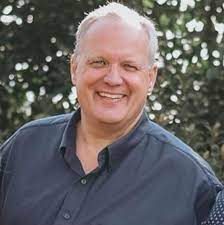Contract Negotiations
What if we have to go on strike to win a fair contract?
Lessons from Yosemite Community College District’s two-day strike
by Jessica Silver-Sharp, Skyline and Cañada College Librarian & AFT 1493 Secretary
With negotiations dragging on and a contract settlement still out of sight, AFT1493 has had to consider the possibility and ramifications of a faculty strike. While the union certainly hopes to avoid having to withhold our labor in order to win a fair contract, after working out of contract for 10 months, we wanted to learn about the experiences of other California community college faculty unions that had actually gone on strike. We reached out to Jim Sahlman, former President of the Yosemite Faculty Association of the Yosemite Community College District to ask about his union’s successful two-day strike back in 2018 and we invited him to AFT’s April membership meeting to answer questions from members on a number of topics.
 Jim Sahlman, former President of the Yosemite Faculty Association
Jim Sahlman, former President of the Yosemite Faculty Association
[Note: The Advocate first interviewed Sahlman in December 2018, just after the strike and right before their union finally reached a contract agreement (read the December 2018 Advocate interview), and then reported on their settlement in the February 2019 issue.]
Questions from members centered mainly on the “how” of planning their strike. Sahlman explained to members in attendance, “We did plenty of research but in the end, we were building the ship as we were sailing it. There hadn’t been a [community college] strike in over 40 years. All the models were outdated.” He explained that their faculty had been working out of contract for three years and were extremely frustrated, and that their district had engaged in regressive bargaining (making offers, but then not offering them) around class caps and other issues crucial to students and faculty.
How did you communicate with members?
Sahlman explained that they held meetings in a central location between their two campuses and created a very popular one page e-newsletter on one topic per week called “The More You Know.” This included updates on bargaining and issues in the District that faculty needed to be aware of, for instance about extremely high administrator salaries.
How did you work with the media and other outside groups?
Sahlman explained that they drafted articles for their local newspaper, The Modesto Bee, and also received strong support from their State Senator who wrote to their District on the union’s behalf. They also “aired the dirty laundry the district was” involved in to news, radio and TV outlets. They relied strongly on their existing connections with their local reporters.
What kind of strike did you do and how much support did you receive?
In their contract negotiations when it was time to declare impasse and vote on a strike they received 95% of faculty votes with 90% voting to strike. First they held an unfair labor practice (ULP) strike for two days in November in the rain to shut down both colleges. When the fact finder subsequently found in their favor but the District still did not settle, they threatened an impasse strike the first day students returned from the Spring break. The District then threatened to fire them if they even talked about striking again and drafted resolutions to do so. The union pushed back loudly and publicly (“Hell No!”) with their lawyer present at all meetings. “We made them out to be these pretty awful people in the process.” The District pulled the resolutions and settled the contract.

Yosemite Faculty Association members rally during their two-day strike
Did you have solidarity or help between your union and the classified folks and students?
They received quiet support from CSEA however their YFA Management group (a leadership team of deans and other management) supported them more publicly. They received a flood of support from students who wanted to go on strike with them and also spoke at board meetings. In classroom discussion, however, they did not talk about striking when students asked questions; they directed them to answers on the union’s webpage. When students asked to help, they asked students to get other students involved.
How did you communicate with faculty?
Over the course of several weeks they created a strike council with roles: people to talk to the media, captains in charge of particular faculty groups, people in charge of food, the strike schedule, sign making, t-shirts. They collected everyone’s cell phone numbers in order to communicate quickly and privately. They didn’t describe the what/when/where of the strike until the last minute so that people couldn’t interrupt it.
What were the low points in the struggle?
Negotiations had fallen apart in March 2018 and it looked like they were going to impasse. They learned they would have to go through mediation and fact finding before they could strike. They made sure to be clear that they were willing to talk (which is the PERB standard), going forward with negotiations while at the same time preparing for strike in late Spring 2018.
In the end, what did you win?
Their union secured a 10% raise at first, with an additional 18% promised.
AFT 1493 extends their heartfelt thanks to Mr. Sahlman for taking the time to speak with our members on April 12, 2023. We wish the Yosemite Faculty Association the best in their future contract negotiations.
